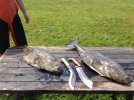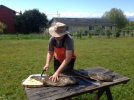- Joined
- Feb 23, 1999
- Messages
- 4,855
Last year about this time I posted about the efficiency of the HI farmcata in steaking up halibut. It was the natural choice due to its handle shape and the virtual impossibility of the knife slipping out of ones grasp.
Since then, our planet made a full revolution around its star. Red Flower and I have eaten all those fish, so we once again ventured forth upon the open sea. This one was a bit rough, so we dont have any sea pictures. There were scattered thunderstorms and big swells, so we were mostly hanging on when we werent reeling in fish. Going out of Greys Harbor, a combination of big swells, a high sandbar, and a low tide made for an interesting bar crossing. Everyone was under orders to stay inside and seated during the bar crossing. The crew passed out buckets, which soon saw a lot of use. The captain was a bit white afterwards, and said it made his top 5 list of bad bar crossings. When we got to the fishing grounds, 20-35 miles out in the Pacific, the seas were still a bit rough. However, it was considerably more regular than the turbulence of the bar.
We did come back with a couple of halibut though. We already know the performance of the farmcata, which is excellent, so this time I thought Id have a showdown. One fish processed with a farmcata, and one with a traditional khukuri. I wanted to use the first khukuri (15 Ang Khola) I bought from Bill in the early 90s. Its seen a lot of use and is still going strong, but unfortunately it was in the back of the vehicle I didnt have with me, far away. I settled on another khukuri of approximately the same dimensions, with a wood handle.

Heres the layout of fish and knives.
The khukuri was first up.




I had already made several chops when I found the wood handle had absorbed the slime on my hand and I had a slimeless grip. I had to stop to reslime myself on the fish to give the knife a real challenge. Even freshly and fully slimed, I felt secure in chopping due to the rear swell on the handle. Due to the curved blade shape on the khukuri it didnt give me the width of chop the farmcata did, although the chop was still surprisingly wide. After the initial chop I cut fish beyond the width of the chop with a draw cut. That worked well and it was only after I was all done I realized I only did a few small push cuts. It would have been good to further test resistance of the central ring against the hand sliding forward. The intuitive way for me was to use the draw cuts, and I didnt even think of anything else until the task was complete. Working as I did, I never felt the slightest insecurity in my grip. Everything was slick enough however, that I did make a practice of withdrawing my off hand holding the fish in the instant before impact.
The farmcata gave the same sterling performance it did last year. (Reached the 5 attached file limit. See last year's post for pics of the farmcata in action.)
Results Id have to give the competition win to the farmcata, but it was close. Grip security was not a factor in the final results. The farmcata got a slight edge due to the wider chops it made, leaving less remnant to slice with the draw cut. However, if the farmcata got a score of 100, the khukuri was close behind with a score of 96. I would feel well-equipped had I only the khukuri to process these fish. An interesting and unexpected result was that the unfinished wood handle on the khukuri was effective in making slime disappear. Many people like to put smooth varnish, boiled linseed oil, or similar polymerizing coatings on their khukuris. Such coatings are beautiful, it can not be denied. However, I think the slime gobbling ability of the bare wood may be sacrificed for the beautiful presentation.
When the testing was over we went inside to slice up some ling cod fillets and vacuum-pack the fish. We did this part inside. Any knife could slice up the boneless fillets to meal-sized portions, but since I had the farmcata out I used it. I brought in one of my old retired cutting boards I dont mind chopping on, and found a flick of the farmcata would nicely section the fillets. Again, it was the length of the chop that dictated knife selection. I could have used the khukuri almost as effectively, but if the chop wasnt placed precisely there still would have been an additional draw cut required.
(Thanks to Red Flower for the photos!)
Since then, our planet made a full revolution around its star. Red Flower and I have eaten all those fish, so we once again ventured forth upon the open sea. This one was a bit rough, so we dont have any sea pictures. There were scattered thunderstorms and big swells, so we were mostly hanging on when we werent reeling in fish. Going out of Greys Harbor, a combination of big swells, a high sandbar, and a low tide made for an interesting bar crossing. Everyone was under orders to stay inside and seated during the bar crossing. The crew passed out buckets, which soon saw a lot of use. The captain was a bit white afterwards, and said it made his top 5 list of bad bar crossings. When we got to the fishing grounds, 20-35 miles out in the Pacific, the seas were still a bit rough. However, it was considerably more regular than the turbulence of the bar.
We did come back with a couple of halibut though. We already know the performance of the farmcata, which is excellent, so this time I thought Id have a showdown. One fish processed with a farmcata, and one with a traditional khukuri. I wanted to use the first khukuri (15 Ang Khola) I bought from Bill in the early 90s. Its seen a lot of use and is still going strong, but unfortunately it was in the back of the vehicle I didnt have with me, far away. I settled on another khukuri of approximately the same dimensions, with a wood handle.

Heres the layout of fish and knives.
The khukuri was first up.




I had already made several chops when I found the wood handle had absorbed the slime on my hand and I had a slimeless grip. I had to stop to reslime myself on the fish to give the knife a real challenge. Even freshly and fully slimed, I felt secure in chopping due to the rear swell on the handle. Due to the curved blade shape on the khukuri it didnt give me the width of chop the farmcata did, although the chop was still surprisingly wide. After the initial chop I cut fish beyond the width of the chop with a draw cut. That worked well and it was only after I was all done I realized I only did a few small push cuts. It would have been good to further test resistance of the central ring against the hand sliding forward. The intuitive way for me was to use the draw cuts, and I didnt even think of anything else until the task was complete. Working as I did, I never felt the slightest insecurity in my grip. Everything was slick enough however, that I did make a practice of withdrawing my off hand holding the fish in the instant before impact.
The farmcata gave the same sterling performance it did last year. (Reached the 5 attached file limit. See last year's post for pics of the farmcata in action.)
Results Id have to give the competition win to the farmcata, but it was close. Grip security was not a factor in the final results. The farmcata got a slight edge due to the wider chops it made, leaving less remnant to slice with the draw cut. However, if the farmcata got a score of 100, the khukuri was close behind with a score of 96. I would feel well-equipped had I only the khukuri to process these fish. An interesting and unexpected result was that the unfinished wood handle on the khukuri was effective in making slime disappear. Many people like to put smooth varnish, boiled linseed oil, or similar polymerizing coatings on their khukuris. Such coatings are beautiful, it can not be denied. However, I think the slime gobbling ability of the bare wood may be sacrificed for the beautiful presentation.
When the testing was over we went inside to slice up some ling cod fillets and vacuum-pack the fish. We did this part inside. Any knife could slice up the boneless fillets to meal-sized portions, but since I had the farmcata out I used it. I brought in one of my old retired cutting boards I dont mind chopping on, and found a flick of the farmcata would nicely section the fillets. Again, it was the length of the chop that dictated knife selection. I could have used the khukuri almost as effectively, but if the chop wasnt placed precisely there still would have been an additional draw cut required.
(Thanks to Red Flower for the photos!)
Last edited:
